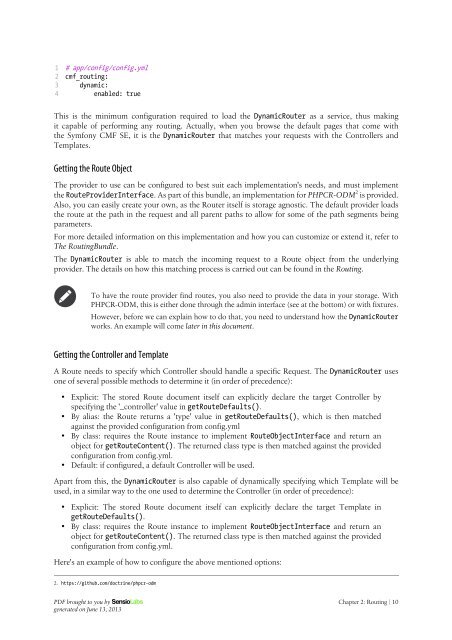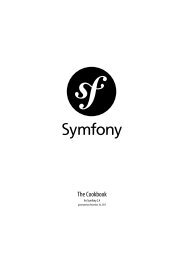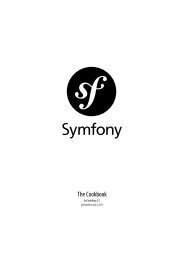The Symfony CMF Book
The Symfony CMF Book
The Symfony CMF Book
Create successful ePaper yourself
Turn your PDF publications into a flip-book with our unique Google optimized e-Paper software.
1<br />
2<br />
3<br />
4<br />
# app/config/config.yml<br />
cmf_routing:<br />
dynamic:<br />
enabled: true<br />
This is the minimum configuration required to load the DynamicRouter as a service, thus making<br />
it capable of performing any routing. Actually, when you browse the default pages that come with<br />
the <strong>Symfony</strong> <strong>CMF</strong> SE, it is the DynamicRouter that matches your requests with the Controllers and<br />
Templates.<br />
Getting the Route Object<br />
<strong>The</strong> provider to use can be configured to best suit each implementation's needs, and must implement<br />
the RouteProviderInterface. As part of this bundle, an implementation for PHPCR-ODM 2 is provided.<br />
Also, you can easily create your own, as the Router itself is storage agnostic. <strong>The</strong> default provider loads<br />
the route at the path in the request and all parent paths to allow for some of the path segments being<br />
parameters.<br />
For more detailed information on this implementation and how you can customize or extend it, refer to<br />
<strong>The</strong> RoutingBundle.<br />
<strong>The</strong> DynamicRouter is able to match the incoming request to a Route object from the underlying<br />
provider. <strong>The</strong> details on how this matching process is carried out can be found in the Routing.<br />
To have the route provider find routes, you also need to provide the data in your storage. With<br />
PHPCR-ODM, this is either done through the admin interface (see at the bottom) or with fixtures.<br />
However, before we can explain how to do that, you need to understand how the DynamicRouter<br />
works. An example will come later in this document.<br />
Getting the Controller and Template<br />
A Route needs to specify which Controller should handle a specific Request. <strong>The</strong> DynamicRouter uses<br />
one of several possible methods to determine it (in order of precedence):<br />
• Explicit: <strong>The</strong> stored Route document itself can explicitly declare the target Controller by<br />
specifying the '_controller' value in getRouteDefaults().<br />
• By alias: the Route returns a 'type' value in getRouteDefaults(), which is then matched<br />
against the provided configuration from config.yml<br />
• By class: requires the Route instance to implement RouteObjectInterface and return an<br />
object for getRouteContent(). <strong>The</strong> returned class type is then matched against the provided<br />
configuration from config.yml.<br />
• Default: if configured, a default Controller will be used.<br />
Apart from this, the DynamicRouter is also capable of dynamically specifying which Template will be<br />
used, in a similar way to the one used to determine the Controller (in order of precedence):<br />
• Explicit: <strong>The</strong> stored Route document itself can explicitly declare the target Template in<br />
getRouteDefaults().<br />
• By class: requires the Route instance to implement RouteObjectInterface and return an<br />
object for getRouteContent(). <strong>The</strong> returned class type is then matched against the provided<br />
configuration from config.yml.<br />
Here's an example of how to configure the above mentioned options:<br />
2. https://github.com/doctrine/phpcr-odm<br />
PDF brought to you by<br />
generated on June 13, 2013<br />
Chapter 2: Routing | 10




